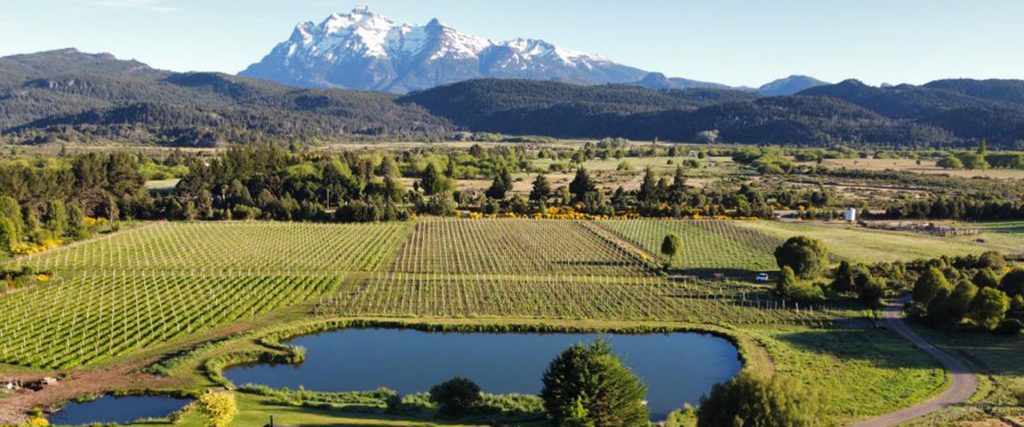Most people think of the winemaking region of Patagonia as being restricted to Alto Valle in Río Negro and San Patricio del Chañar in the province of Neuquén. However, over the past fifteen years, a handful of producers has started to explore new terroirs in the province of Chubut, around the 42nd parallel and even further, searching for the perfect southern Patagonia wine.
Today, thanks to the courage and effort of these winemakers, there are around a dozen vineyards scattered across the province that are producing some very interesting wines unique on the Argentine wine scene.

The new Southern Patagonia wine
The first chapter of southern Patagonia wine production in the extreme south was written by Bernardo Wienert, a winemaker from Mendoza with a summer house in El Hoyo near Epuyén, a picturesque spot in the Patagonian Andes, which he realized was at a comparable latitude to Burgundy. In 2000 he decided to plant a vineyard of white grapes and Merlot in conditions that had never been tried before in Argentina.
Here, the Andes are lower, allowing wind from the Pacific to come down the mountain slopes, bringing cool air and humidity with it. Rainfall here is between 600 and 1000mm per year and temperatures are cold for most of it.
With lows as cold as -12°C in winter, frosts can also occur even in summer representing a constant threat that obliges producers to use water spraying systems to protect against cold fronts in a way similar to that seen in Canada and Germany.
The soils, which are rich in organic matter, mean that the plants’ natural vigour must be restrained in order to obtain good quality fruit although, thanks to the slope and loose soils of sand, rock and limestone, the drainage is excellent.
Unsurprisingly, it took a while before the vineyards were productive but the effort proved worthwhile: people are gradually following in Wienert’s footsteps, in the hopes of exalting the legacy of southern Patagonia wine. For instance, fellow pioneer Pedro Adamow makes an exquisite Sauvignon Blanc while a few miles away in the province of Rio Negro, Camilo de Bernardi is the only winemaker in El Bolsón and produces a Burgundy-style Pinot Noir.
Trevelin, Argentina’s latest GI
In 2012, a few residents of Trevelin, an Andean region on the 45th parallel, also began to show an interest in winemaking. Nanty Fall and Contra Corriente, two tourism enterprises from the area, were the first to plant vines at a height of 350 meters above sea level.
Later, in 2015, Casa Yagüe joined the cluster of southern Patagonia wine producers who in 2019 obtained Geographic Indication status for Trevelin.
‘Wines from Trevelin are unique in Argentina. We’re in an extreme area for wine production because of the frosts and wind and this is reflected in well-balanced wines with high acidity and low alcohol content that maintain their intensity well, while the aromas are enhanced by the freshness,’ says Sofía Elena, Head of Wine at Contra Corriente.
With greater rainfall and a colder climate, the terroir is even tougher than that found on the 42nd parallel; getting the fruit ripe is a challenge every year. Consequently wineries concentrate mainly on white varieties such as Chardonnay, Sauvignon Blanc, Riesling, and Gewürztraminer, with one or two also trying out Pinot Noir. The resulting southern Patagonia wines stand out for their vibrancy and sharp acidity. This is true, for instance, of the Chardonnay and Sauvignon Blanc from Casa Yagüe, and Chardonnay 2018, Pinot Noir and Gewürztraminer from Contra Corriente. Nanty Fall, meanwhile, is producing notable Rieslings and Pinot Noirs. All three are exploring the potential for sparkling wines.
The most southerly vineyard in the world
But the new vineyards of Patagonia aren’t just found in the Andean foothills. In fact, the most southerly are located in the middle of the steppe, where the climate can be as dry and sunny as Cuyo in Mendoza.
These vineyards belong to the Otronia winery, located in Capitán Sarmiento, at 45º latitude. This is a very different kind of winemaking: the climate is arid and extremely windy although the risk of frost is similar to that in the mountains.
In spite of the challenges, the intrepid winemakers at Otronia, Alberto Antonini and Juan Pablo Murgia are working with Gewürztraminer, Pinot Grigio, Chardonnay and Pinot Noir, grapes with which they make an excellent white blend and classic Burgundy varietals, as well as an extremely fresh sparkling wine produced using the traditional method. Their best vintages so far are Otronia Blend de Blancas 2017, 45 Rugientes Pinot Noir 2018 and Otronia Chardonnay 2019.
‘Being so far south ensures that the average temperature will be 11°C, i.e.: cold, which is the most relevant factor. This comes out in the unique character of the wines, which present significant natural acidity that preserves the pure, rich aromas as well as providing balance and refinement in the Pinot Noirs and Chardonnays,’ says Murgia.
Issues of origin
Until last year, wines from Chubut tended to labelled as being from the Patagonia Geographic Indication that applies to all the irrigated valleys in the region. However, as mentioned above, from August 2019 onwards, Trevelin obtained its own Geographic Indication while the rest of the winemaking pockets of the region are in the process of obtaining the same status so as to consolidate their introduction of new geographies and styles to the Argentine wine scene.


